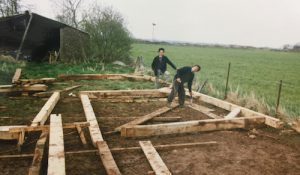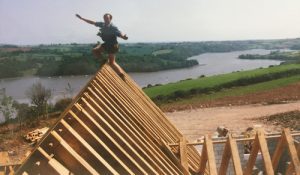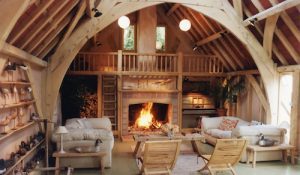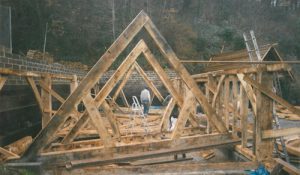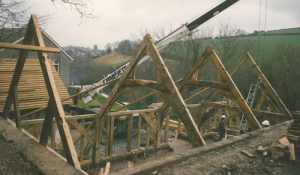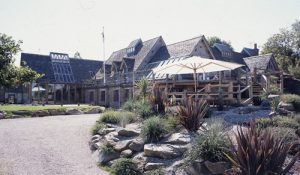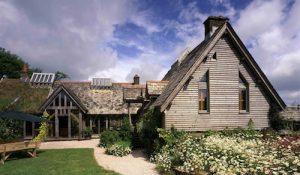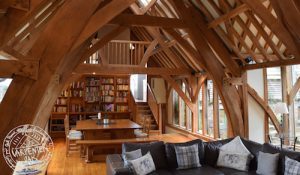In October 2016, Carpenter Oak got the chance to revisit Lamper Head, one of our earliest and well-known builds, a short distance from our Devon yard.
Before Lamper Head was realised, all that stood on the top of a windswept South Hams hillside was a dilapidated, asbestos tennis pavilion. Whilst the existing structure was modest, the views from it formed a panorama that spanned the River Dart, from the vineyards at Sharpham to the north, to the village of Dittisham in the south and the fringes of Dartmoor on the horizon. It was a view that struck project manager, Adam Milton, from his first site visit and one that deserved a structure that would be able to make the most of such spectacular scenery.
“The frame for Lamper Head was built outside, in a field in 1991. It was one of the biggest frames we’d done at the time, very challenging in the workshop because of the huge truss blades. I remember being really enamoured by the site. It was a beautiful summer and we spent a week putting it up. The clients were fantastic and they were really excited about building this new venture for the family. My wife and I were thinking about moving down in this direction and after we built the frame we camped at Lamper Head and thought ‘this is such a magical spot.’”
- Off-site assembly
- Adam Milton on site
- Completed frame
At that time, Carpenter Oak and Woodland was still based solely in Chippenham. The two founding directors, Charlie Brentnall and Roderick James met working on a folly by a lake. Roderick liked converting barns but also wanted to build new structures because there was a shortage of stone barns. Charlie was mostly involved with repair and conservation work and in bringing those ideas and skills together with a new build direction, the company was formed in 1987.
Following on from the ground-breaking Seagull House, built and owned by Roderick and just a couple of miles from the Lamper Head site, the frames acted as a springboard for the company and the second yard in Devon started in 1995.
- Seagull House interior
- Building Seagull House
- View from the tennis court
“Both projects had great publicity and great photographs” remembers Adam. “A lot of clients approached us and we always insisted they come to Seagull House and Lamper Head. It was a real launching pad and hit a note with what people wanted at that time.”
Since 1991, Lamper Head has undergone various re-fits, including a Douglas Fir framed swimming pool with floor to ceiling glazing making the most of the views. Its current owners, Janet and Stephen Shipperley rent it out as a holiday let. “Lamper Head is very special to our family” said Janet. “We love the place and as soon as we drive through the gates we feel that it is time to unwind. It is truly a place of tranquillity. The house is an example of pure craftsmanship, teamed with an eye for interior design, giving it a traditional but at the same time contemporary feel. It is truly unique. It also has the advantage of being in the most fabulous location with views to die for.”
- Approach to Lamper Head
- Lamper Head
- Living room interior
Carpenter Oak today, and tomorrow. . .
Adam has seen the oak framing industry expand and evolve, as well as techniques and people’s tastes.
“It’s moved on, definitely. But at the heart of it, we’re still building cruck frames, sling brace trusses – including the show-barn here – so we still do very similar work, just some of the techniques have moved on. Some projects are very different, using steel and glulam. That’s quite a leap forward. Some people would walk into Lamper Head today and find it too much. Too much timber, too much oak. A lot of our clients now want something pared back.”
“Air-tightness is a key factor these days and the different glazing techniques we’ve used have adapted and improved, which was all part of the learning process in applying modern materials into a centuries-old type of structure. A big leap forward is how our buildings are now ‘wrapped up.’ With products like SIPs, hempcrete and German wood fibre, it’s really exciting how that can encase a structure that can still move and breath, rather than a plasterboard or steel box.”
“One of the big areas we’re spending a lot of time at the moment is working on bringing the two companies, back together again. A lot of that is about the ethos of the company. As an industry it’s amazing how many people who’ve spent time at Carpenter Oak. What we want to do is create a company for the future. It’s all about the people. Yes we make things, but it’s a craft and keeping good people, enjoying the work, the social side and the environment is something that we really want to be at the core of the business. I’ve been doing this for 30 years and it’s how the next generation – our successors – move the company into its next chapter – giving people the opportunity to diversify and use Carpenter Oak’s brand to do that.”
